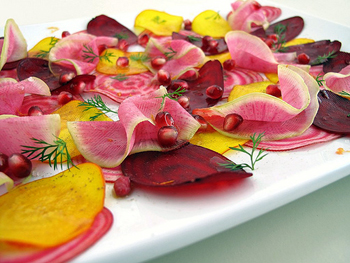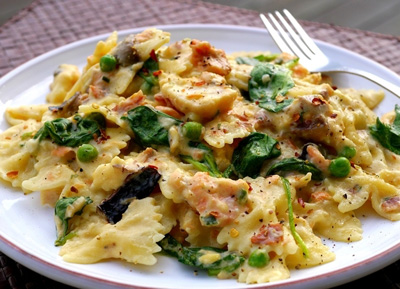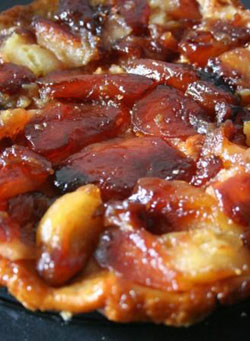 Eat your beets! We've all heard that from our moms quite often as kids. Unfortunately it was more often canned beets that we were persuaded to eat. As a curious eater, I've come to appreciate beets in many different preparations. I especially love them roasted in salads. But have you ever thought of eating them raw? Sliced very thinly, beets and other root vegetables, make great salads. Yes, it's possible to slice them thin with a knife, but a mandoline does the job better than anything else to get paper-thin shavings.
Eat your beets! We've all heard that from our moms quite often as kids. Unfortunately it was more often canned beets that we were persuaded to eat. As a curious eater, I've come to appreciate beets in many different preparations. I especially love them roasted in salads. But have you ever thought of eating them raw? Sliced very thinly, beets and other root vegetables, make great salads. Yes, it's possible to slice them thin with a knife, but a mandoline does the job better than anything else to get paper-thin shavings.
In this beautiful salad I combine three different colors of beets, plus a watermelon radish, and add pomegranate seeds for additional ruby color. The radish adds a different type of crunch and hotness. The pomegranate seeds along with a squeeze of orange juice add sweetness and tang to the salad. A sprinkling of dill adds green color as well as herbal flavor. After trying this salad, you will be surprised to find how naturally sweet beets taste when eaten raw. They are nature's candy in both taste and color.
Winter
Winter
Leftover Holiday Cheese and Smoked Salmon Pasta
 Now that the holiday feeding frenzy is over (well, sort of) we are left with hunks and wedges of cheese and packages of smoked salmon. I swear my cheese drawer looks like a graveyard of half eaten-half scooped items. But there is no reason to let them go to waste and they are easily re-purposed into something amazing.
Now that the holiday feeding frenzy is over (well, sort of) we are left with hunks and wedges of cheese and packages of smoked salmon. I swear my cheese drawer looks like a graveyard of half eaten-half scooped items. But there is no reason to let them go to waste and they are easily re-purposed into something amazing.
We were lucky enough to have smoked salmon around this holiday season. But don't worry, this recipe would work well with any leftover salmon or fish you have now or throughout the year.
I shredded up some wedges of cheese, about 3-1/2 to 4 cups total. I used Parmesan, Dubliner, Pepper Jack and Monterey Jack and I had about 1-1/4 pounds of leftover smoked salmon.
To make things even easier, I used a can of Progresso Recipe Starters Creamy Three Cheese Cooking Sauce as part of the base for my sauce. Have you tried these yet? They are so great to have in the pantry when you are needing a quick meal.
Finally...It's Bean Season
From the LA Times
 Some people mark the start of fall with an apple pie. Others start breaking out the big reds from their wine cellars. Me? I'm a bean boy.
Some people mark the start of fall with an apple pie. Others start breaking out the big reds from their wine cellars. Me? I'm a bean boy.
All it takes is the first sign of a nip in the air or the first morning that smells like ocean rain and I drag my Dutch oven out of the cupboard and start a big pot of beans simmering.
It doesn't really matter that I know the next day may be back up in the 90s. In fact, that uncertainty even makes it a little sweeter.
That week of rain we had at the end of September? A Portuguese-style stew of white beans with shrimp and clams, given a final lift by chopped pickled peppers.
A week or so later, after the 100-degree temperatures had lifted? White beans braised with dandelion greens and served as a bed for crisp-skinned duck breasts (the leftovers, without the duck, were just as good a couple of nights later, with a few tablespoons of grated Parmigiano-Reggiano stirred in).
Winter Fruit
 Sounds funny, right? “Winter fruit”. It’s a sorry state of affairs, especially in California where we can get so many splendid things almost all year round AND believe it or not, we DO have winter.
Sounds funny, right? “Winter fruit”. It’s a sorry state of affairs, especially in California where we can get so many splendid things almost all year round AND believe it or not, we DO have winter.
The Farmers Market web sites list what’s in season and during winter the list looks like it’s trying too hard. With un-enticing things like Gogi and Ground Cherry (what the…?) it looks like a parent making excuses for their untalented child. When I clicked on the Fruit icon at LocalHarvest.com it showed an array of exciting things like apricots and melons, only to find out that they were hocking the seeds to grow them with for ‘sweet goodness grown at home.’ Jesus!
The one fruit that gets to shine during winter is the apple. I love apples. I’m so glad the growers of Delicious got it together and stopped growing that mush bomb. Red Delicious has returned to the apple of my childhood. Hard as a rock, crisp, juicy and sweet.
Meyer Lemon Pasta
 My love for Meyer lemons continues this week with another dish using these amazingly flavorful citrus fruits. This time it's a pasta dish that's done in less than 15 minutes. It's meatless, so it's great for vegetarians. But the savory flavors of garlic and crushed red pepper will also appeal to the meat-and-potatoes guys. But what really lifts this dish is the Meyer lemons, which add a tantalizing zing that refreshes the palate.
My love for Meyer lemons continues this week with another dish using these amazingly flavorful citrus fruits. This time it's a pasta dish that's done in less than 15 minutes. It's meatless, so it's great for vegetarians. But the savory flavors of garlic and crushed red pepper will also appeal to the meat-and-potatoes guys. But what really lifts this dish is the Meyer lemons, which add a tantalizing zing that refreshes the palate.
As fast as you can boil pasta is as fast as you can make this recipe. The sauce is made with just the lemons and some pasta water. Then it's a matter of finishing it off with Parmesan cheese and parsley.
Make this meal in minutes—it's perfect for the weeknight when you're lacking the time or creativity to make anything complex. And if you can't find Meyer lemons, use regular ones and get results that are just as great.
More Articles ...
Welcome to the new One for the Table ...
Our Home Page will be different each time you arrive.
We're sure you'll find something to pique your interest...

